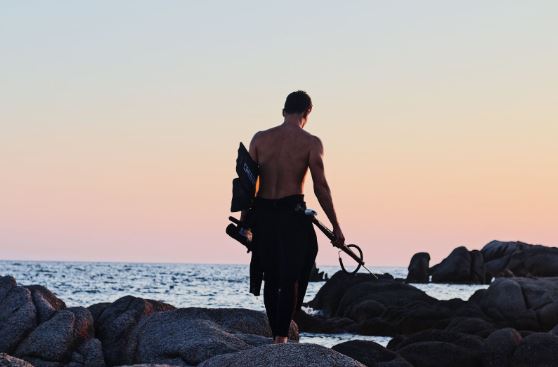Did you know the best dive spots might be just a few steps away from where you sunbathe? Welcome to the world of shore diving! Forget the boat—just don your gear, take a few steps from the beach, and immerse yourself in an underwater wonderland. Many breathtaking dive sites are nestled right off the coast, debunking the myth that only boat dives can lead you to aquatic marvels. While some may believe it’s a pursuit solely for the seasoned diver, the truth is, shore diving can be both accessible for newcomers and challenging for veterans. Sure, it might demand a bit more effort than hopping off a boat, but the rewards? Absolutely worth it. If you’ve yet to give shore diving a go, you’re in for a treat.
Why Shore Diving?
Dive on Your Own Time
One benefit of shore diving is that it frees you up from boat schedule restrictions. You should always schedule your shore dive when conditions are ideal, but the timing is entirely up to you and your dive buddy. You have control over the dive’s length and depth as well as the time and location. You can dive for as long as you want since you don’t feel pressured to surface because other divers finished diving and are waiting for you on board.
Cost-Effective Diving
Another advantage of shore diving is that it is typically less expensive because there’s no need to plan transportation to the dive site and incur boat expenses. If you’re looking for a low-cost option but still want to experience a one of a kind underwater experience, shore diving can be the best choice for you.
Uncharted Territories

Anyone interested in shore diving can find fantastic locations all around the world, from Bali in Indonesia to Curacao in the Caribbeanand even right here in the United States. Bonaire is considered as the shore diving capital of the world, this premium dive location has uneasy access to almost 60 shore dive sites. Bonaire’s coral reefs offer some of the best shore diving in the entire world, with more than 470 different species of fish, including angelfish, tarpon, octopuses, moray eels, crustaceans, and turtles, which are expected to see here.
Overcoming First-Time Nerves
Familiarize Before You Dive
Together, you and your dive buddy hold the keys to a successful dive trip. Shore entries can range from leisurely walks along sandy shores to navigating challenging rocky terrains. It’s vital to identify potential hazards along the coast—be it rugged landscapes or steep inclines—that might pose a risk to you or your equipment. Landmarks, such as lighthouses or prominent rock formations, can be invaluable for navigation. Coordinate with your buddy to decide your entry and exit spots, and consistently use your compass underwater to stay oriented. The mantra? Plan the dive, then dive the plan!
Engaging with fellow divers offers a wealth of site-specific insights. Probe about the ease or complexity of entry and exit points. Leveraging the expertise of local dive shops can be invaluable. More often than not, they’ll have a deep understanding of nearby dive spots, and might even furnish you with maps, charts, and essential tips—from ideal parking areas to the best entry and exit zones, ensuring you’re well-informed about the dive site.
Mental Preparedness
Feeling a touch of anxiety while scuba diving is perfectly natural. One effective way to mitigate this is through controlled breathing exercises. Taking long, measured breaths not only conserves air but also ensures your body remains oxygenated, inducing a sense of calm. It’s beneficial to cultivate a pre-dive routine that centers you. Always remember: as a scuba diver, you’re embarking on this journey for the sheer joy and thrill of the experience.
Tips and Tricks for a Smooth Dive
The Perfect Entry
When you arrive at the dive site, roam down to the beach and examine the water. Be aware of potential environmental hazards including rip currents. It’s best to leave and pick a different dive site if you think that the location has too many challenges. Arrive at the location early enough to explore the surroundings before preparing your entry. Check the tidal schedules and the weather forecasts in advance to see if you might encounter difficulties during the dive. Shore entries do require some getting used to- especially if there is a lot of surf. But it doesn’t have to be terrible; planning your entry and exit in advance will make this lot less intimidating.
Navigation Know-How
Don’t forget to look for a point of reference on land before entering. Choose a large stationary object on the beach, such as a big rock or a tree. You can use this visual guide to discover your entry point on the way back and to remain on track on the way there. Communicate with your dive buddy all the time, remember that two eyes are better than one so you must help each other out. It’s always the best idea to have a dive buddy, but it’s especially crucial while shore diving. Whether it’s assisting each other in putting on your fins, coordinating your entry and exit from the water, or assisting each other in the event of an emergency, excellent communication is essential. Throughout the dive, communication is paramount.
 Essential Gear for Shore Diving
Essential Gear for Shore Diving
Dive Flags – Signal Your Spot!

Dive flags are used to alert boats and other watercraft that divers are in the area, possibly near the surface. The dive flag should be fixed on a float that is easily seen from a passing boat and keeps the flag unfurled and above the water whether you are diving on the shore or by a boat.
Proper Footwear
Diving is made simpler and more enjoyable with the right footwear. While exploring underwater terrains, your feet are kept secure and comfortable by dive booties or any other specially made boots. They primarily serve to protect your feet from any sharp items and rocky or rough surfaces you may come upon when diving. To achieve the best fit and performance, numerous variables should be taken into account while purchasing dive boots. This includes the right thickness and fit or sizing.
The Right Weight
Scuba divers must be properly weighted to maintain good buoyancy. Your body composition, the gear and clothing you’re wearing, and many other things can affect your buoyancy. Dives can be made safer by adding weights to your scuba weight belt or the pockets on your BCD. This will help minimize drag and promote more efficient diving.
Environmental Stewardship
Leave No Trace
It is important to be fully aware of the impact you could potentially make on the marine environment. As a diver, you should contribute to the protection of the environment. The principle ‘Leave No trace’ must be always practiced. That is treating marine life as a fragile environment and avoiding touching or even taking things as a ‘souvenir’. Minimize your impact on the environment by bringing a reusable water bottle and taking any trash with you.
Dive Site Etiquette
Always be aware of other divers and the reef surrounding you. Although the underwater surroundings are captivating, try to avoid running into the reef or colliding with other divers while admiring it. Keep your buoyancy under control and be mindful of your position. In order to give everyone room to move, hold back a few feet. No one is perfect, and we all occasionally make mistakes. Learn more about Marine Life Etiquette in this article
Post-Dive Delight
Log and Brag!
Experiences are best when shared! Share your diving experiences on social media and note your underwater experiences in your logbook. A dive log serves as a memory book for you and helps you share information about places you have already been. You can track your development as a diver and gain confidence by logging your dives.
Conclusion

Imagine standing at the edge of the beach, the waves lapping at your feet, with the knowledge that just beyond lies an aquatic world filled with shipwrecks, vibrant coral reefs, and a spectrum of marine life waiting to be explored. No boats, no schedules – just you, your gear, and the ocean. That’s the beauty of shore diving.
While boat dives have their thrill, shore diving empowers you with a unique sense of autonomy. The control is entirely in your hands – from picking the site to determining the duration of your dive. Remember, diving from the shore can be just as exhilarating as diving from a boat, if not more. The onus is on you to ensure you’re equipped and well-prepared, but the sense of adventure and discovery is unmatched.
From the iconic shores of Bonaire to hidden spots only locals know about, the globe is teeming with pristine shore diving sites. So, if you’ve ever been disheartened about missing out on a boat dive, remember there’s a world beneath the waves right off the shore, beckoning you. As you plan your future dives, consider the path less taken – the one that starts on the sand and leads to underwater wonders.
And once you’ve taken the plunge, we’re all ears! Dive stories are best when shared. Enlighten us with your shore diving escapades and snapshots in the comments below. Dive in and let the ocean tales begin!
You might have heard about the Blue Heron Bridge, check this article to learn more on why it has been voted as one of the top shore diving destinations in the US.
Updated on: December 05, 2023



 Essential Gear for Shore Diving
Essential Gear for Shore Diving